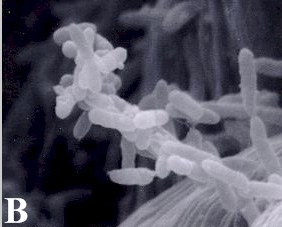Acetobacter
A Microbial Biorealm page on the genus Acetobacter

Classification
Higher order taxa:
Bacteria; Proteobacteria; Alphaproteobacteria; Rhodospirillales; Acetobacteraceae
Species:
Acetobacter calcoaceticus; Acetobacter cerevisiae; Acetobacter cibinongensis; Acetobacter diazotrophicus; Acetobacter estunensis; Acetobacter indonesiensis; Acetobacter lovaniensis; Acetobacter malorum; Acetobacter orientalis; Acetobacter orleanensis; Acetobacter pasteurianus; Acetobacter peroxydans; Acetobacter polyoxogenes; Acetobacter pomorum; Acetobacter subgen. Acetobacter aceti; Acetobacter syzygii; Acetobacter tropicalis; Acetobacter sp.
|
NCBI: |
Description and Significance
Acetobacter bacteria, such as Acetobacter diazotrophicus that can be isolated from coffee plants or sugarcane, are acid-producing, nitrogen-fixing bacteria. In fact, the A. diazotrophicus-sugarcane relationship, first observed in Brazil, was the first report of a beneficial symbiotic relationship between grasses and bacteria through nitrogen fixation. Nitrogen-fixing bacteria are important in modern agriculture - exploiting these bacteria would decrease the present dependency on nitrogen fertilizers, which would have positive results for the ecosystem and the health of humans and other animals. Other strains can be found in samples from Japanese rice vinegar (komesu) or unpolished rice vinegar (kurosu).
Genome Structure
Acetobacter bacterial genomes currently have yet to be sequenced.
Cell Structure and Metabolism
Acetobacter is an obligatory aerobic, nitrogen-fixing bacteria that is known for producing acid as a result of metabolic processes. While all nitrogen-fixing bacteria contain nitrogenase in order to utilize atmospheric nitrogen gas as a source for metabolic biosynthesis, different nitrogen-fixing microorganisms protect the oxygen-sensitive microorgansims from oxygen exposure in different ways. A. diazotrophicus has been called interesting because it carries out nitrogen fixation under aerobic conditions. It needs oxygen for the production of large quantities of ATP required for nitrogen fixation; however, little is known about the mechanism or system that protects the nitrogenase under aerobic conditions. A. diazotrophicus is a plant endophyte and has been said to be capable of excreting about half of its fixed nitrogen in a form that plants can use.
Ecology

with Acetobacter diazotrophicus colonization.
From The University of Arizona
Acetobacter bacteria can be found in symbiotic relationships with many different plants, such as sugarcane and coffee plants, as well as in fermenting vinegar. Endophytes are prokaryotes that associate with plants by colonizing their internal tissues. Many of these bacteria have been observed to promote plant growth, but the mechanisms behind this relationship are not yet fully understood. Below is a table of places where A. diazotrophicus can be found.
| Sugarcane | root, root hair, stem, leaf |
| Cameroon grass | root, stem |
| Sweet potato | root, stem tuber |
| Coffee | root, rhizosphere, stem |
| Ragi | root, rhizosphere, stem |
| Tea | root |
| Pineapple | fruit |
| Mango | fruit |
| Banana | rhizosphere |
| Others - mealy bugs, VAM spores | internal environment |
Vinegar
In Japan, the polished rice vinegar komesu and the unpolished rice vinegar kurosu are traditional seasonings that are made through saccharification of rice, alcohol fermentation, and oxidation of ethanol to acetic acid. The traditional and most common method for producing these vinegars is called static surface acetic acid fermentation: an alcoholic liquid with vinegar, called moromi, is fermented in covered containers to prevent bacterial contamination; after a few days, a crepe pellicle of acetic acid bacteria, which are generally in the Acetobacter genera, covers the moromi surface and the fermentation is allowed to continue for about a month. Weak acid acetate is a typical product of microbial metabolism and is known for its cytotoxic effects like the retardation of growth. This is related to the "weak lipophilic nature of the undissociated acid that enables the molecule to cross the cytoplasmic membrane" (Steiner and Sauer 2001). This movement of molecules is thought to throw off ion gradients, increase the internal acetate concentration, and/or disrupt the natural processes of the membrane. Very few microorganisms are known to be relatively resistant to high concentrations of acetate; bacteria in the genera Acetobacter and Gluconobacter, both of which are used in static vinegar fermentation, are two of the most known acetic acid bacteria (Steiner and Sauer 2001).
References
General:
- The University of Arizona: Importance of Biological Nitrogen Fixation
Cell Structure and Metabolism:
- Flores-Encarnacion, M., M. Contreras-Zentella, L. Soto-Urzua, G. R. Aguilar, B. E. Baca, and J. E. Escamilla. 1999. "The respiratory system and diazotrophic activity of Acetobacter diazotrophicus PAL5." Journal of Bacteriology, vol. 181, no. 22. American Society for Microbiology. (6987-6995)
Ecology:
- Muthukumarasamy, R., G. Revathi, S. Seshadri, and C. Lakshminarasimhan. 2002. "GluconAcetobacter diazotrophicus (syn. Acetobacter diazotrophicus), a promising diazotrophic endophyte in tropics." Current Science, vol. 83, no. 2. (137-145)
Vinegar
- Nanda, Kumiko, Mariko Taniguchi, Satoshi Ujike, Nobuhiro Ishihara, Hirotaka Mori, Hisayo Ono, and Yoshikatsu Murooka. 2001. "Characterization of acetic acid bacteria in traditional acetic acid fermentation of rice vinegar (komesu) and unpolished rice vinegar (kurosu) produced in Japan." Applied and Environmental Microbiology, vol. 67, no. 2. American Society for Microbiology. (986-990)
- Steiner, Peter and Uwe Sauer. 2001. "Proteins induced during adaptation of Acetobacter aceti to high acetate concentrations." Applied and Environmental Microbiology, vol. 67, no. 12. American Society for Microbiology. (5474-5481)
